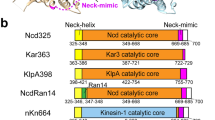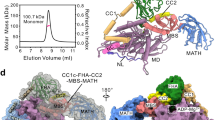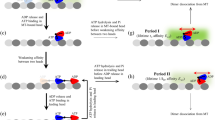Abstract
Kinesin-1 is an ATP-driven, processive motor that transports cargo along microtubules in a tightly regulated stepping cycle. Efficient gating mechanisms ensure that the sequence of kinetic events proceeds in the proper order, generating a large number of successive reaction cycles. To study gating, we created two mutant constructs with extended neck-linkers and measured their properties using single-molecule optical trapping and ensemble fluorescence techniques. Owing to a reduction in the inter-head tension, the constructs access an otherwise rarely populated conformational state in which both motor heads remain bound to the microtubule. ATP-dependent, processive backstepping and futile hydrolysis were observed under moderate hindering loads. On the basis of measurements, we formulated a comprehensive model for kinesin motion that incorporates reaction pathways for both forward and backward stepping. In addition to inter-head tension, we found that neck-linker orientation is also responsible for ensuring gating in kinesin.
This is a preview of subscription content, access via your institution
Access options
Subscribe to this journal
Receive 12 print issues and online access
$189.00 per year
only $15.75 per issue
Buy this article
- Purchase on Springer Link
- Instant access to full article PDF
Prices may be subject to local taxes which are calculated during checkout





Similar content being viewed by others
References
Svoboda, K., Schmidt, C.F., Schnapp, B.J. & Block, S.M. Direct observation of kinesin stepping by optical trapping interferometry. Nature 365, 721–727 (1993).
Asbury, C.L., Fehr, A.N. & Block, S.M. Kinesin moves by an asymmetric hand-over-hand mechanism. Science 302, 2130–2134 (2003).
Kaseda, K., Higuchi, H. & Hirose, K. Alternate fast and slow stepping of a heterodimeric kinesin molecule. Nat. Cell Biol. 5, 1079–1082 (2003).
Yildiz, A., Tomishige, M., Vale, R.D. & Selvin, P.R. Kinesin walks hand-over-hand. Science 303, 676–678 (2004).
Block, S.M., Goldstein, L.S. & Schnapp, B.J. Bead movement by single kinesin molecules studied with optical tweezers. Nature 348, 348–352 (1990).
Coy, D.L., Wagenbach, M. & Howard, J. Kinesin takes one 8-nm step for each ATP that it hydrolyzes. J. Biol. Chem. 274, 3667–3671 (1999).
Hua, W., Young, E.C., Fleming, M.L. & Gelles, J. Coupling of kinesin steps to ATP hydrolysis. Nature 388, 390–393 (1997).
Schnitzer, M.J. & Block, S.M. Kinesin hydrolyses one ATP per 8-nm step. Nature 388, 386–390 (1997).
Svoboda, K. & Block, S.M. Force and velocity measured for single kinesin molecules. Cell 77, 773–784 (1994).
Block, S.M. Kinesin motor mechanics: binding, stepping, tracking, gating, and limping. Biophys. J. 92, 2986–2995 (2007).
Guydosh, N.R. & Block, S.M. Not so lame after all: kinesin still walks with a hobbled head. J. Gen. Physiol. 130, 441–444 (2007).
Rosenfeld, S.S., Fordyce, P.M., Jefferson, G.M., King, P.H. & Block, S.M. Stepping and stretching. How kinesin uses internal strain to walk processively. J. Biol. Chem. 278, 18550–18556 (2003).
Yildiz, A., Tomishige, M., Gennerich, A. & Vale, R.D. Intramolecular strain coordinates kinesin stepping behavior along microtubules. Cell 134, 1030–1041 (2008).
Kozielski, F. et al. The crystal structure of dimeric kinesin and implications for microtubule-dependent motility. Cell 91, 985–994 (1997).
Hyeon, C. & Onuchic, J.N. Internal strain regulates the nucleotide binding site of the kinesin leading head. Proc. Natl. Acad. Sci. USA 104, 2175–2180 (2007).
Hariharan, V. & Hancock, W.O. Insights into the mechanical properties of the kinesin neck-linker domain from sequence analysis and molecular dynamics simulations. Cell Mol. Bioengineering 2, 177–189 (2009).
Guydosh, N.R. & Block, S.M. Backsteps induced by nucleotide analogs suggest the front head of kinesin is gated by strain. Proc. Natl. Acad. Sci. USA 103, 8054–8059 (2006).
Klumpp, L.M., Hoenger, A. & Gilbert, S.P. Kinesin′s second step. Proc. Natl. Acad. Sci. USA 101, 3444–3449 (2004).
Crevel, I.M. et al. What kinesin does at roadblocks: the coordination mechanism for molecular walking. EMBO J. 23, 23–32 (2004).
Schief, W.R., Clark, R.H., Crevenna, A.H. & Howard, J. Inhibition of kinesin motility by ADP and phosphate supports a hand-over-hand mechanism. Proc. Natl. Acad. Sci. USA 101, 1183–1188 (2004).
Nishiyama, M., Higuchi, H. & Yanagida, T. Chemomechanical coupling of the forward and backward steps of single kinesin molecules. Nat. Cell Biol. 4, 790–797 (2002).
Carter, N.J. & Cross, R.A. Mechanics of the kinesin step. Nature 435, 308–312 (2005).
Hyeon, C., Klumpp, S. & Onuchic, J.N. Kinesin′s backsteps under mechanical load. Phys. Chem. Chem. Phys. 11, 4899–4910 (2009).
Liepelt, S. & Lipowsky, R. Kinesin′s network of chemomechanical motor cycles. Phys. Rev. Lett. 98, 258102 (2007).
Rice, S. et al. A structural change in the kinesin motor protein that drives motility. Nature 402, 778–784 (1999).
Visscher, K., Schnitzer, M.J. & Block, S.M. Single kinesin molecules studied with a molecular force clamp. Nature 400, 184–189 (1999).
Valentine, M.T. et al. Precision steering of an optical trap by electro-optic deflection. Opt. Lett. 33, 599–601 (2008).
Coppin, C.M., Pierce, D.W., Hsu, L. & Vale, R.D. The load dependence of kinesin′s mechanical cycle. Proc. Natl. Acad. Sci. USA 94, 8539–8544 (1997).
Svoboda, K., Mitra, P.P. & Block, S.M. Fluctuation analysis of motor protein movement and single enzyme kinetics. Proc. Natl. Acad. Sci. USA 91, 11782–11786 (1994).
Shaevitz, J.W., Block, S.M. & Schnitzer, M.J. Statistical kinetics of macromolecular dynamics. Biophys. J. 89, 2277–2285 (2005).
Chemla, Y.R., Moffitt, J.R. & Bustamante, C. Exact solutions for kinetic models of macromolecular dynamics. J. Phys. Chem. B 112, 6025–6044 (2008).
Valentine, M.T., Fordyce, P.M., Krzysiak, T.C., Gilbert, S.P. & Block, S.M. Individual dimers of the mitotic kinesin motor Eg5 step processively and support substantial loads in vitro. Nat. Cell Biol. 8, 470–476 (2006).
Moffitt, J.R., Chemla, Y.R. & Bustamante, C. Methods in statistical kinetics. Methods Enzymol. 475, 221–257 (2010).
Guydosh, N.R. & Block, S.M. Direct observation of the binding state of the kinesin head to the microtubule. Nature 461, 125–128 (2009).
Asenjo, A.B. & Sosa, H. A mobile kinesin-head intermediate during the ATP-waiting state. Proc. Natl. Acad. Sci. USA 106, 5657–5662 (2009).
Mori, T., Vale, R.D. & Tomishige, M. How kinesin waits between steps. Nature 450, 750–754 (2007).
Toprak, E., Yildiz, A., Hoffman, M.T., Rosenfeld, S.S. & Selvin, P.R. Why kinesin is so processive. Proc. Natl. Acad. Sci. USA 106, 12717–12722 (2009).
Valentine, M.T. & Gilbert, S.P. To step or not to step? How biochemistry and mechanics influence processivity in Kinesin and Eg5. Curr. Opin. Cell Biol. 19, 75–81 (2007).
Hackney, D.D. Evidence for alternating head catalysis by kinesin during microtubule-stimulated ATP hydrolysis. Proc. Natl. Acad. Sci. USA 91, 6865–6869 (1994).
Alonso, M.C. et al. An ATP gate controls tubulin binding by the tethered head of kinesin-1. Science 316, 120–123 (2007).
Hackney, D.D., Stock, M.F., Moore, J. & Patterson, R.A. Modulation of kinesin half-site ADP release and kinetic processivity by a spacer between the head groups. Biochemistry 42, 12011–12018 (2003).
Blackman, M.J. et al. Structural and biochemical characterization of a fluorogenic rhodamine-labeled malarial protease substrate. Biochemistry 41, 12244–12252 (2002).
Kawaguchi, K. & Ishiwata, S. Nucleotide-dependent single- to double-headed binding of kinesin. Science 291, 667–669 (2001).
Gutiérrez-Medina, B., Fehr, A.N. & Block, S.M. Direct measurements of kinesin torsional properties reveal flexible domains and occasional stalk reversals during stepping. Proc. Natl. Acad. Sci. USA 106, 17007–17012 (2009).
Schnitzer, M.J., Visscher, K. & Block, S.M. Force production by single kinesin motors. Nat. Cell Biol. 2, 718–723 (2000).
Rosenfeld, S.S., Xing, J., Jefferson, G.M., Cheung, H.C. & King, P.H. Measuring kinesin′s first step. J. Biol. Chem. 277, 36731–36739 (2002).
Behnke-Parks, W.M. et al. Loop L5 acts as a conformational latch in the mitotic Kinesin Eg5. J. Biol. Chem. 286, 5242–5253 (2011).
Hiratsuka, T. New ribose-modified fluorescent analogs of adenine and guanine nucleotides available as substrates for various enzymes. Biochim. Biophys. Acta 742, 496–508 (1983).
Acknowledgements
S.M.B. acknowledges support from grant GM51453, and S.S.R. acknowledges support from grant AR048565 from the US National Institutes of Health.
Author information
Authors and Affiliations
Contributions
B.E.C., W.M.B.-P. and J.O.L.A. designed and carried out experiments, collected and analyzed data, and cowrote the paper. B.E.C. and J.O.L.A. carried out modeling and fits. S.M.B. and S.S.R. helped to design experiments and analyze results, and cowrote the paper.
Corresponding author
Ethics declarations
Competing interests
The authors declare no competing financial interests.
Supplementary information
Supplementary Text and Figures
Supplementary Figures 1–6 and Supplementary Methods (PDF 493 kb)
Rights and permissions
About this article
Cite this article
Clancy, B., Behnke-Parks, W., Andreasson, J. et al. A universal pathway for kinesin stepping. Nat Struct Mol Biol 18, 1020–1027 (2011). https://doi.org/10.1038/nsmb.2104
Received:
Accepted:
Published:
Issue Date:
DOI: https://doi.org/10.1038/nsmb.2104



